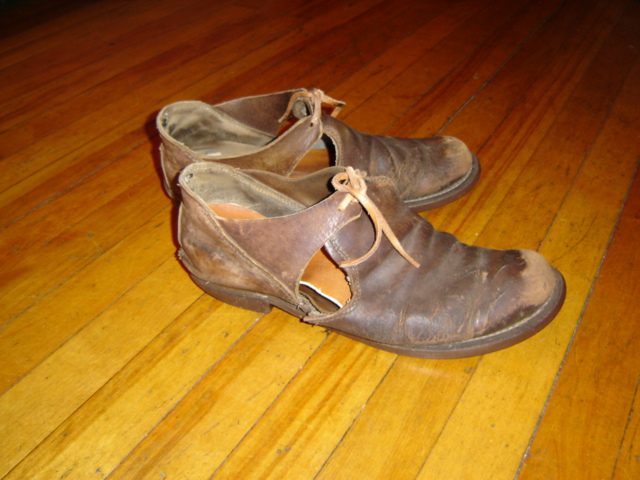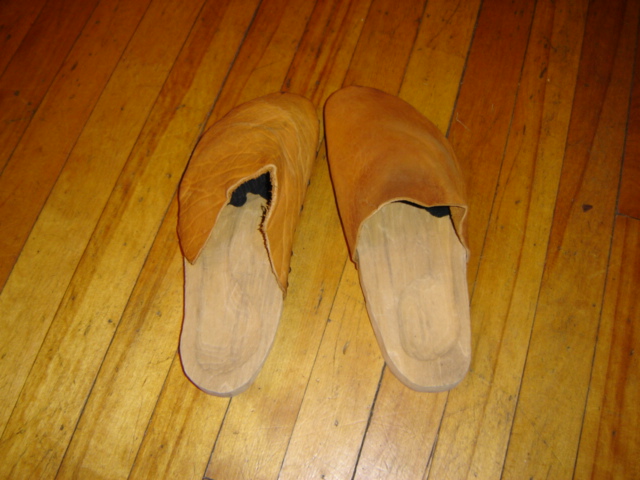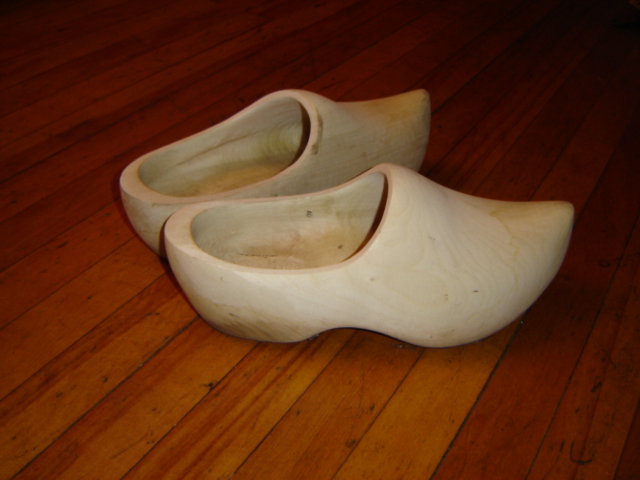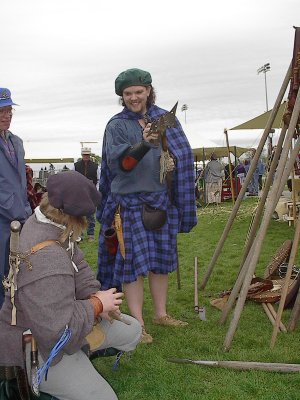Seventeenth Century Shoes
It has been said that one can judge a living history group's dedication to accuracy in their portrayal by looking at their feet. Period correct footwear can be one of the more difficult and expensive items in putting together a period outfit, but using an otherwise good-looking kit can be spoiled by not having proper footwear. Following is the result of research on period footwear, with the intention of helping 16th and 17th century reenactors improve this part of their kit.
There is a glossary at the end of this article. Hopefully, I have glossed everything necessary.
Also, you will find a short list of businesses that sell ready made period footwear.
As you know from reading your manuals, Scots - especially Highlanders - frequently went barefoot in our period. Broken glass, however, was something 17th century Highlanders would have rarely encountered.
There were many different types of shoe in the period in question.
In the past, our members have generally worn one of four types of footwear: moccasins, ghillies, latchet shoes, and high boots (this is the proper term; the term "bucket tops" is later).
Two of the above-mentioned four types of footwear are not correct for us.
Moccasins, being Native American footwear, are of course not correct for Northern Europeans – even if you cut off the fringe. Although originally allowed for brand new members when our organization was first forming, thankfully, we have pretty much done away with these.
Ghillies are a whole 'nother beast. They have the advantage that
they are easy to make. There are some surviving shoes from the
British Isles that vaguely resemble our ghillies, but they date to
before AD 900 (Saguto, p.1, and Carlson).
According to leading shoe scholars, ghillies as we know them are a
modern invention based roughly on some
surviving early medieval shoes, apparently a result of a combination of
wishful thinking and a desire to come up with something for renaissance
fairs, rendezvous, and such that is cheap, easy to make, and does not
look obviously modern.
Even home made shoes in the 17th century were shaped to the foot – unlike ghillies, which are essentially a leather bag.
The term ghillie, itself, is a modern construct (Saguto, p.1). In 1894, Mackay listed about sixteen varieties of Celtic footwear from the Middle Ages to the early modern period; nothing resembling ghillies, nor even the term itself, appears (pp.141 ff.).
There is NO documentation for anything resembling ghillies anywhere approaching our period and place. Obviously, ghillies - or anything else that predates our period by seven or more centuries - are not the ideal to which we should aspire.
Latchet Shoes: In the 17th century, the promise of acquiring
latchet shoes (along with food, pay, and a decent set of clothes) was
one of the reasons men would join an army in the first place.
Usually constructed using a last, (but see brogues below) latchet shoes can be made with or without heels, and may have large openings, or not, between the quarters and the vamp.
Some surviving latchet shoes have hobnails attached to extend the life of the soles.
There is some evidence to suggest that rich folk had big openings, in order to show off their expensive silk hose, and poor folks' latchet shoes were "closed", i.e did not have a gap between quarters and vamp, to better protect the foot. For example, there were many closed latchet shoes found on the Swedish warship Vasa (sunk in 1628, raised in 1961), but very few open latchet shoes; this suggests a distinction in footwear between sailors and officers (Brzezinski and Hook p 40).
Also, Beabey (pp. 21-22, 23) suggests that open latchet shoes (being more fashionable) are civilian shoes, and closed latchet shoes (being more practical) are military.
Latchet shoes are available ready made in prices ranging from $60 to ca. $540, although some of the cheaper ones have soles that are glued on, rather than stitched. I have seen a pair of these lose their soles to the mud.
Another option is to modify a pair of modern shoes, such as Romeos.
High Boots are certainly correct, especially for officer portrayals,
although there is documentation of Scottish infantry captains who wore
latchet shoes in the Thirty Years War (1618-1648) and the British Civil
War (1638-1651). They are designed for riding, not walking, so
they were common amongst cavalry and the gentlemanly class who could
afford horses. Musketeers and other low-lifes would sometimes wear
high boots, but they were putting on airs doing so. Or, as Beabey
points out (p.22), it is likely that period illustrations of pikemen
and musketeers wearing high boots are actually depictions of dragoons
(i.e. mounted infantry).
High boots can also be bought ready made at prices ranging up to $800 or more - see below.
Or one can modify a pair of modern boots (although they are getting hard to find, surplus East German Army jackboots seem to be popular for this).
**************************************************************************************
Now then - if you don't want to plunk down $150 for a decent pair of latchets, or up to $1000 for good pair of high boots, do not worry. There are other options.
A number of common types of well-documented 17th century shoe are easy to make. Amongst others, these include turnshoes, cloggis, and pampooties.
Turnshoes: A turnshoe is a (usually) soft-soled shoe which is stitched together inside out, then turned right side out. This method of construction protects the stitching from wear. Any shoe constructed in this manner, regardless of the form of its uppers, is a turnshoe. There were many varieties over the centuries.
Some turnshoes were so constructed, turned right side out, then had an extra sole stitched to them.
Some Scottish turnshoes were made with fashionable uppers (e.g. made to look like proper latchet shoes). These were commented upon by later 17th century Englishmen, who disparagingly called them single-soled shoes (“proper” shoes having hard soles often made of several thicknesses of leather).
Turnshoes were on the way out (in terms of fashion), being gradually displaced by latchet shoes from about 1570 to 1630, but they certainly were still around in our period. They were cheaper than latchet shoes, so poor folks still were having them made. Rich folks still wore them indoors, as they are so very comfortable, but they were not considered suitable for dress occasions (I. M. Carlson, pers. comm.).
Davis has a well illustrated article on a group of footwear including turnshoes recovered from the wreck of Basque whaler San Juan, sunk in 1565 in Labrador. There are scale diagrams of these turnshoes. Anyone who can stitch leather should be able to make these.
 Cloggis: A
clog is any shoe with a wooden sole. Often times
cloggis would be made by the person who needed them, rather than hiring a cordwainer. Also, some
"traveling folk" (British so-called Gypsies) made a living making clog
soles.
Cloggis: A
clog is any shoe with a wooden sole. Often times
cloggis would be made by the person who needed them, rather than hiring a cordwainer. Also, some
"traveling folk" (British so-called Gypsies) made a living making clog
soles.
Cloggis are a "poverty shoe". In fact, Holmes' "Academy of Armory" published in 1688, refers to them as "Clog, or countreymans shooe".
They are very practical in northern climes, as wood insulates the feet much better than leather from the cold, wet ground. In one form or another, they were in use throughout much of Europe in our period.
Cloggis could and did have many different types of upper. The more one could make them look like professionally-made shoes, the less embarrassment for the wearer. I have seen cloggis made to look like latchet shoes, mules, and so on.
Regardless of the type of upper, cloggis could also have hobnails, again to increase the life of the sole.
These are even easier to make than turnshoes, requiring only a saw to shape the sole, a scissors or knife to cut the leather, and a hammer and nails to attach the leather upper to the wooden sole. Depending on type of upper desired, there is often no sewing of leather required.
It is better to use a hardwood such as oak or ash for the soles, rather than pine or some other soft wood, as hardwood soles last much longer.
Wooden soles can be carved to make arch support; for that matter, simple orthotic (corrective) cloggis can also easily be made. Simply step on your sole with damp (not dripping wet) feet. Using a pencil, have someone else draw the outline of your feet (it is important to have that other person do this, as feet change shape whether one is standing or not). Then, remove your feet and draw the outline of the water pattern made by your feet as you stand . Use a gouge to carve out within the lines, checking the fit periodically until you have happy feet.
Pampooties: These are the type of shoe common in Scotland in our
period for the "Clansman, tenant, and 'Humblie'" (Saguto, p1). Pampooties (the Hebridean term), cuarans
(Highlands and Ireland), and rivelins
(English/Scots) all refer to the same shoe, which was generally made of
rawhide with the hair still on.
'Humblie'" (Saguto, p1). Pampooties (the Hebridean term), cuarans
(Highlands and Ireland), and rivelins
(English/Scots) all refer to the same shoe, which was generally made of
rawhide with the hair still on.
Unlike so-called ghillies – which are a bag shoe – pampooties are somewhat shaped to the foot.
In a paper written for the Appin Stewarts, a Virginia-based 18th century Scottish reenactment group fighting for Bonnie Prince Charlie, Saguto gives instructions on how to make two versions of this shoe.
One of the varieties is based on an Aran Isle (Ireland) pampootie collected in the 19th century, which very neatly matches a description in a letter written to King Henry VIII by Scottish clerk John Elder in 1543: “After that we have slayne redd deir we flaye of the skyne bey and bey, and settinge of our bair foote on the insyde thereof, for neide of cunnynge shoemakers ... we play the sutters; compasinge and mesuringe so muche therof, as shall retche up to our ancklers, pryckynge the upper part thereof also with holis, that the water may repas when it entres, and stretchide up with a stronge thwange of the same, meitand above our saide ancklers, so, ... we make our shoois: Therefor, we usinge such maner of shoois, the roghe hairie syde outwart, in ... England, we be callit roghe footed Scottis;” (Quoted in Mackay, p.137).
This description is echoed a century and a half later: “The shoes anciently wore were a piece of the hide of a deer, cow, or horse, with the hair on, being tied behind and before with a point of leather.“ (Martin, p.128)
Martin also mentions the use of sealskin for such shoes (p.219) but this material is pretty tough to get hold of these days.
Pampooties have no stitching in them, being simply bound together with leather thong. Lack of stitching thread is the hallmark of homemade Scottish shoes – especially those made by Highlanders - throughout our period (Mackay, p. 142)
The Aran Islanders were still making these in an unbroken tradition at least as recently as the 1980s. They are expected to last about a month of daily hard use, which should be several seasons for reenactors.
Lest you worry about rawhide shoes wearing your feet away, they tend to pick up some moisture from the ground. This, along with simply wearing them regularly, keeps them fairly soft. If they have not been worn for a while, they can simply be soaked in water for a bit to soften them back up. Within a few minutes of putting them on, excess water is squeezed out through the simple expedient of walking.
Furthermore, if they are made from hide fresh off the beast, they form to your foot before hardening,
If you would rather not use rawhide for your pampooties, though, go ahead and use tanned leather. Martin indicates that the trend by the end of the 17th century at least was away from rawhide to tanned leather (p.128).
**************************************************************************************
Other types of period shoe:
Brogues: These latchet shoes are a turnshoe, with a stiff sole stitched on after turning, sometimes with a low heel added as well. They were "favoured by the Scottish and Irish mercenaries who fought for numerous armies throughout Europe in the 17th century " (Beabey, p. 22). A photo of Beabey's reconstruction is found in his article on page 18. There are instructions on making brogues in The Clann Tartan Manual (Nordin).
 Klompen:
“Dutch” wooden shoes., actually used throughout much of
Europe, including Spain, France, Belgium, Netherlands, Germany,
and most of Scandinavia (Wilcox). The toe was commonly pointed in
the Low Countries and France, but usually rounded off elsewhere.
They are not easy to make without specialist tools, but very affordable
to us moderns. See Sources for ready made footwear below.
Klompen:
“Dutch” wooden shoes., actually used throughout much of
Europe, including Spain, France, Belgium, Netherlands, Germany,
and most of Scandinavia (Wilcox). The toe was commonly pointed in
the Low Countries and France, but usually rounded off elsewhere.
They are not easy to make without specialist tools, but very affordable
to us moderns. See Sources for ready made footwear below.
Startups: Not well documented, but Beabey states that these lace-up calf boots are "believed to have seen service in many 17th century armies." (p. 22) There is a photo of a pair made by him based on a surviving boot at the Duetches Ledermuseum, Offenbach (p. 23).
Words to the wise:
For lower-class or military impressions especially, use the leather rough side out. This was done to lessen apparent wear and tear, as the rough side doesn't scuff as easily.
Avoid suede; it does not last at all long.
Avoid chrome-tanned leather. Apart from some hideously inappropriate colors, even the browns and tans just don't look right.
If you decide to try hobnails, make sure you have two pair of period shoes. Hobnails must not be worn indoors, as they will brutalize modern flooring. Also be warned that they can also slip on pavement. They are fine in grass, dirt, or mud, though.
As far as color goes, men's shoes were not always black until the 19th century. Working class folks are usually depicted in 17th century art with tan or brown shoes and boots; rich folk also used other colors as well as black.
Sources:
Beabey, Mark. "17th Century Boots and Shoes Reconstructed" in Military Illustrated Past & Present #57, Feb 1993. This article describes the "materials, construction methods and styles of military footwear". It is by a British reenactor who is a full-time maker of reproduction leather work; see Bjarnis Boots below.
Brzezinski, Richard and Hook, Richard. The Army of Gustavus Adolphus: 1 Infantry. Men-at -Arms Series #235, Osprey Publishing Ltd, London, 1991
Carlson, I. Marc. Footwear of the Middle Ages: An Ongoing Examination of the History and Development of Footwear and Shoemaking Techniques up to the End of the Sixteenth Century This very useful online book is available at http://www.personal.utulsa.edu/~marc-carlson/shoe/SHOEHOME.HTM
Clann Tartan Manual Edition V Clann Tartan, Minneapolis, MN 2002.
This collection of scores of research articles on various aspects of
reenacting 16th - 17th century Scots by many members of Gaffneyis
Regiment is available for purchase from www.clanntartan.org
Davis, Stephen. "Piecing Together the Past: Footwear and Other
Artefacts from the Wreck of a 16th-Century Spanish Basque Galleon." In
Artefacts from Wrecks. Dated Assemblages from the Late Middle Ages to
the Industrial Revolution, ed. M. Redknap. Oxford: Oxbow Books on
behalf of the Nautical Archaeology Society and Society for
Post-Medieval Archaeology, 1997.
Holme, Randle. The Academy of Armory or, A Storehouse of Armory and Blazon Chester, England, 1688. Marc Carlson has put the relevant shoe portion in facsimile online at http://www.personal.utulsa.edu/~marc-carlson/histshoe/holme/holme1.htm In addition to the "Clog, or countreymans shooe", this also contains woodcuts of an "Irish Broge" and an "Island shooe".
Knutson, Charles. “Footwear” in Clann Tartan Manual Edition V Clann Tartan, Minneapolis, MN 2002, Book 2, pp 26 - 27.
Mackay, J. G. “Notes on a Pair of Pampooties, or Shoes of Raw Hide, from Aran More, Galway Bay.” Proceedings of the Society of Antiquaries of Scotland 1893-1894 v.28 pp. 136-150.
Martin, Martin. A Description of the Western Islands of Scotland Circa 1695, etc. Introduction by Charles W. J. Withers and R. W. Munro. Birlinn Ltd., Edinburgh, 1999.
Nordin, Jeff. “Brogues” in Clann Tartan Manual Edition V, Minneapolis, MN 2002 Book 2, p 28.
Saguto, Al. "Pampooties" 1984, revised 1999. Available at
www.appins.org/pampooties.htm Mr. Saguto is the resident
cordwainer at Colonial Williamsburg.
Wilcox, Turner. Mode in Footwear Scribner's Sons, NY, 1948.
Sources of Ready Made Period Footwear:
Apart from the latchet shoes sold by Sykes Sutlery and Museum Replicas, and the klompen sold by Bushwoman, I have not examined any of these products; caveat emptor. This list is provided as a service, not an endorsement. Prices generally do not include shipping.
Armlann sells a closed latchet shoe for $60, and high boots for $250.
Bjarni Boots (Mark Beaby's company) sells latchet shoes from £300, startups from £450, and high boots from £550 (the pound is currently worth roughly $1.80). He also sells leather mugs, buckets, buffcoats, saddles and more. I have to believe that although pricey, his product excels.
Bushwoman (Shirlee Pfeil) sells klompen at rendezvous (Big Island, for example) for $30. The pointed toes can be filed or sanded down if you wish.
Historic Shoes offers a good looking closed latchet shoe for $60.
S. B. Juniper makes several varieties of period footwear, including latchet shoes, high boots, and mules in the £100 - £450 range. The work on her website looks superb, as it should – she is the shoe supplier for Plimouth Plantation.
Museum Replicas carries an open latchet shoe for $70.
Plantagenet Shoes markets several varieties of latchet shoe from £115 to £145.
Sykes Sutlery carries very good looking latchet shoes for $150.
Glossary:
Cobbler - One who repairs shoes
Cordwainer - English term for a shoemaker, from Cordoba, Spain, which produced the best shoe leather for centuries (Scots corollary is cordiner)
Crooked lasted - shoes made with a left and a right, like modern shoes
Hobnails - short shanked nails with curved or pointed heads, used by soldiers to prolong the life of soles from Roman times until at least WWII
Last - a carved wooden mock foot over which shoes are stitched together
Mule - a slipper-like shoe with a vamp, but no quarters
Pump - a type of turnshoe with no laces or ties, which stays on the foot merely by closeness of fit
Quarters - that portion of the upper that goes around one's heel
Souter or Suter - Scots English term for shoemaker, from the Latin sutor
Straight lasted - shoes made that could go on either foot
Upper - that portion of a shoe above the sole
Vamp - that portion of the upper that covers the front of the foot

